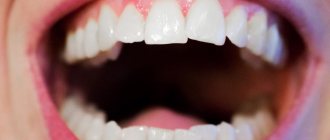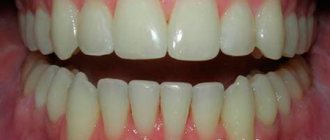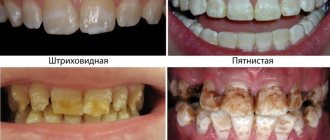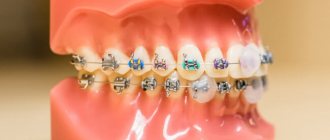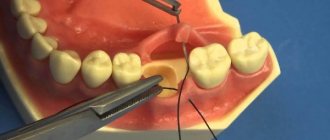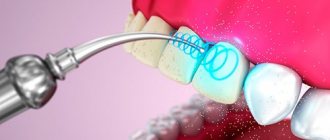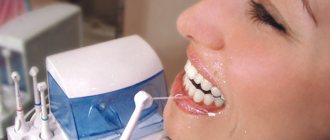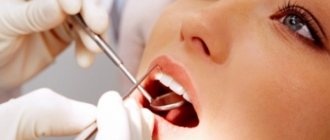Remember when your teeth grew as a child?
Oryol writer and yogi Sergei Veretennikov believes that only with the power of thought can you launch a dental growth program in your body. And to do this, you first need to remember all the sensations that you experienced in early childhood when your teeth were growing. This is the first and most important button we press.
The second button is to concentrate attention on the two lower front incisors, which are the first to grow in a person in childhood. And the third button - concentration of attention on the point between the eyebrows (on the third eye) with the thought - I am growing new teeth. And if you keep these buttons “on” most of the day, success is guaranteed.
The main enemies in this process are unbelief (by faith, what will be given to you) and fear, especially the fear that the new teeth will somehow interfere with the remaining ones (they will not interfere, it has been proven in practice). But the most insidious enemy is still human laziness, and not only in the matter of restoring teeth. It is she who forces us to resort to the services of doctors, although our most important healer is ourselves...
Why are baby teeth delayed in eruption?
If a child was born with low weight and signs of rickets, premature, weakened and sick in the first months of life, then these unfavorable factors will certainly affect the body and cause delayed teething.
By 9–12 months the teeth have not yet erupted and the child is healthy? Ask your grandmothers at what age your mothers and fathers got teeth. Typically, late teething is genetic. The Russian pediatrician G.N. Speransky was the first to draw attention to this heredity. During his medical practice, he observed this feature in 2-3 generations of children.
But the same genetic characteristics can also affect earlier teething. Previously, this was considered a bad omen, and in New Guinea there was a cruel custom - if a child was born with one or two teeth, he was sacrificed to the gods. It was believed that such a child would bring disaster to his family. But these are all prejudices, and there is nothing wrong with the appearance of early teeth, and there is no reason to worry either.
Wanted and grew new teeth
Mikhail Stolbov lost his teeth in the army in the late seventies of the last century. They were simply knocked out for him, since at that time hazing flourished in the Armed Forces of the USSR - real criminal lawlessness (very indicative in this case is the story of the world-famous healer and spiritual leader M. Norbekov, to whom in the army, at approximately the same time, old-timers completely The kidneys were knocked out, but he later restored them - read his biography).
We invite you to familiarize yourself with Phlegmon of the floor of the mouth
While still in the army, Stolbov was given cheap dentures instead of his natural teeth, and he lived with them, replacing them whenever possible with better ones, but he never managed to get used to them. He was especially depressed by the tongue-tiedness that appeared for this reason. One day, by the will of fate, Mikhail found himself in the remote taiga. And at this time his gums hurt, so much so that he was forced to give up dentures and completely switch to ground and porridge-like food.
Mikhail himself later wrote that first you need to believe in this miracle, then switch to a healthy lifestyle and diet (in this case, living in the taiga, far from civilization, helped him), because without accumulating the necessary energy in the body, nothing will come of it. And then you should learn to hear your body and try to see and feel how your teeth grow.
How do you know if your first tooth will erupt soon?
Increased production of saliva is the very first sign of the imminent appearance of a tooth. Saliva begins to flow profusely about a couple of months before the tooth appears, as the nerve endings are irritated. The baby is preparing to chew solid food, and nature provides for the food in the mouth to be abundantly moistened with saliva.
We suggest you read: Sweet saliva in the mouth causes
Due to his age, the baby still has nothing and nothing to chew, and he has not yet learned to swallow saliva. To prevent saliva flowing down the neck from irritating your baby's delicate skin, use soft baby wipes.
Myth about the name
People began to call eights "wise" due to the fact that they cut in the period from 14 to 26 years, while the remaining molars grow until about 10-11 years. It is believed that by the time the outermost molars are cut through, a person has already gained intelligence and they are symbolized by this. Of course, this myth is in no way connected with reality, because this molar in a person can begin to climb at the age of 11-12, and sometimes they remain completely under the gum for the rest of your life. Modern dentists note that many modern children (about 35% of visitors) lack these extreme painters.
One of the theories, so to speak, “folk”, is associated with late periods of eruption. Allegedly, after 20 years of life, a person has already gained some experience and become wiser.
The scientific or “Darwinian” theory says that this happened during evolution. Human ancestors, monkeys, used their teeth not only for chewing and grinding food, but also for turning improvised devices and tools and participating in fights, so they lost them in their youth. And the third molars appeared late precisely so that the monkeys, already in old age, could at least somehow process food.
We invite you to familiarize yourself with Caries in the spot stage, medical history
Do molars grow back after extraction in children?
Between the ages of 6 months and 3 years, a child grows 20 baby teeth, after which the period of permanent teeth begins to appear. Despite the fact that the growth of molars is almost painless, the process requires control and attention from adults. What do parents need to know about changing teeth in children?
Why does a person's teeth change?
The structure and development of the dentition in different animals differs significantly from each other. In vertebrates and some species of reptiles, for example, teeth change several times in their lives, and over time, a new one grows in place of the lost tooth; in rodents, permanent teeth immediately grow. This is due to the characteristics of the body, residence and nutrition of representatives of the animal world.
There are several species of mammals whose teeth change once in their lifetime during childhood.
This is necessary not only for the growth of the body, but also for survival - after the baby stops feeding on mother’s milk, its life largely depends on the capabilities of the dental apparatus.
Humans can also be classified as mammals in this category, so changing teeth is an integral process of growing up for them.
How are baby teeth different from molars?
A human tooth consists of three main parts: the visible part (crown), the root, which is recessed into the gum tissue, and the neck, located between them. Despite the fact that the general structure and functions of primary and permanent teeth are similar, there are still differences between them:
- the surface shade of temporary teeth is white, while permanent teeth are yellowish;
- the tissues of the molars are denser and harder, and the pulp is much larger;
- the shape of the milk teeth is flat and wide, the molars are quite long (the width is significantly less than the length);
- The roots of baby teeth are thinner and shorter than those of permanent teeth.
During the process of loss of temporary teeth and the appearance of permanent teeth, the child’s jaw actively grows, and by the time it ends it reaches an adult size - thanks to this, 32 permanent teeth grow in place of 20 temporary teeth.
When does teeth change?
Permanent teeth in a child’s body are formed approximately in the fifth month of intrauterine development, and by the time of birth, the gums contain almost fully formed rudiments of temporary and permanent teeth.
The timing and order of their change may vary depending on a number of factors, including heredity, the quality of water and food, the presence of chronic diseases and the individual characteristics of the body.
In addition, statistics say that this process begins earlier in girls than in boys.
Baby teeth begin to fall out around the age of 5 to 7 years, and permanent teeth appear in their place over time.
The general order of appearance of molars is exactly the same as for milk teeth - they grow in pairs, starting from the lower jaw.
The molars (sixes) appear first, but since they do not have milk “brothers”, they simply stand in line with the temporary teeth. The rest of the order of teeth growth is as follows.
Table. Approximate timing of teething.
Names of teethApproximate period of eruption, years
| Incisors in the center | 6-7 |
| Incisors on the sides | 7-8 |
| Fangs | 9-12 |
| First molars | 9-11 |
| Second molars | 10-12 |
The appearance of so-called wisdom teeth (or eighth teeth) occurs much later - around the age of 20, and in some people they do not appear at all. The growth rate of different teeth differs significantly - the front incisors grow the fastest, while molars and premolars have slow, difficult growth.
Deviations from the generally accepted timing and schedule for changing teeth should not cause panic among parents - most often this is simply a feature of the baby’s body. If the process is delayed too much (a permanent tooth does not appear in the place of the fallen one within 3-4 months), parents should consult a doctor to rule out the presence of diseases.
Tooth growth may be delayed due to rickets or endocrine disorders, as well as due to pathologies associated with tooth formation. These include primary adentia and retention of permanent teeth: in the first case, the tooth germs in the tissues are completely absent, and in the second they are incorrectly located, which is why the tooth cannot cut through the tissues.
Unlike baby teeth, molars do not cause much discomfort to children. The following signs may indicate that a child’s teeth will soon begin to change:
- baby teeth begin to loosen;
- the gaps in the dentition increase, free space appears;
- sometimes redness and swelling appear in the areas of future molars, less often - swelling with transparent contents.
In rare cases, children may complain of itching and discomfort in the gums, as well as increased tooth sensitivity. The process proceeds naturally: the root of the baby tooth dissolves, after which a permanent one appears in its place.
To alleviate the condition, you can purchase special ointments or pastes with a calming and analgesic effect.
An increase in temperature indicates an inflammatory process that occurs in the tissues - this condition requires medical consultation and treatment.
What should parents do?
The main task of parents during the period when their baby’s teeth are changing is to ensure good oral hygiene and monitor the proper growth of teeth. Any dental defects should be corrected in the early stages so that the baby’s smile is even and beautiful.
- It is not recommended to loosen or pull out baby teeth - this can only be done if the loose tooth greatly interferes with the child. You can try to gently pull it out with clean fingers wrapped in a piece of gauze - in cases where this cannot be done, you should consult a doctor.
- Under no circumstances should you pick your teeth with foreign objects, especially sharp ones. In addition, while changing teeth, it is better to limit the consumption of sweets and hard foods such as nuts or crackers.
- If, after a tooth has fallen out, a bleeding wound has formed at the site of the tooth, you need to give the baby a piece of cotton wool or a sterile bandage to compress the wound, refuse food for about two hours, and do not eat hot or spicy foods for 24 hours. You should not burn the affected area with concentrated antiseptics, as this can lead to a burn of the mucous membrane. You should also not rinse your mouth too intensively - after a tooth falls out, a blood clot forms in place of the tooth, which protects the tissues from infection.
- The most difficult teeth to fall out are those that have undergone treatment; their roots usually have to be surgically removed.
- If teeth fall out too quickly, it is better for parents to see a dentist - too much free space can cause teeth to grow crooked. Bad habits can also lead to bite defects - adults need to ensure that the child does not suck fingers or bite nails.
A child’s nutrition plays a very important role during the period of teeth change. Due to active changes in the body, the need for phosphorus and calcium increases, so low-fat fish, cottage cheese, dairy products, fresh vegetables and fruits should be included in the baby’s diet.
How to take care of your teeth during your shift?
The child does not need any special measures to care for the oral cavity during the period of changing teeth - teeth should be brushed twice a day, and after each meal, rinse the mouth with water.
Brushing your teeth should not be too intense - for complete hygiene, it is enough to brush your teeth for a minute with a special soft brush and children's toothpaste.
To prevent infection from getting into wounds left after teeth loss, you can prepare herbal decoctions (chamomile, oak bark, etc.) or buy special rinses.
You need to start caring for your teeth immediately after they appear - the tooth enamel of a recently erupted tooth is still very fragile and susceptible to the influence of negative factors.
If permanent teeth have an unnatural color or stains appear on their surface, you need to consult a doctor as soon as possible - this may indicate an early stage of caries or other pathologies (lack of nutrients or impaired metabolism).
If dentists' recommendations are followed and parents are attentive, the child's molars will be healthy and his smile will be snow-white and beautiful.
— Stages of changing baby teeth to permanent ones
Category: Tooth extraction Published by Mister stomatolog
Source: https://kosmetik-dent.ru/vyrastayut-li-korennye-zuby-posle-udaleniya-u-detej/
Can teeth grow a third time?
It turns out that there are many such cases, however, on the scale of our planet, this is a drop in the ocean. Unfortunately, the mechanism of such tooth regeneration is still unknown, although, according to the sages, people of previous civilizations, say, the Hyperboreans and Atlanteans, did not suffer from lack of teeth in old age, which is typical for modern people.
However, they also knew how to levitate, teleport, read minds, move and lift objects with their thoughts (for example, the Mayan tribes did not know wheels, but they moved any loads and multi-ton stone slabs with fantastic ease that we can only dream of) and much more. But even today there are people capable of all this. There are also those lucky ones who experienced the third change of teeth...
Can new teeth grow a third time?
It turns out that this is quite possible, and what’s more, it has been documented in medicine that new teeth grow not in infants, but in adults and the elderly. True, there are few such cases, but they still exist. And this is the very principle and mechanism of the growth of new teeth in an adult, according to the testimony of that person himself. Let's look below.
Who among us has not dreamed that his teeth would never hurt, and if a tooth had to be pulled out, then a new one would certainly grow in the place of the removed one. Moreover, there is no science fiction in this, since many sea and land animals have this ability - to change teeth throughout their lives, for example, elephants, sharks and others.
Surprisingly, this ability also breaks through in people. It breaks through, because sometimes older citizens actually suddenly grow new snow-white teeth for the third time, as in childhood instead of milk teeth. Scientists have long been interested in this fact.
An incompletely erupted wisdom tooth is a different story
As a result, purulent swelling is formed. This inflammation of the hood is called pericoronitis.
If a patient has a burning desire to preserve a wisdom tooth affected by deep caries and possibly even pulpitis, then in the vast majority of cases this is almost impossible to do due to impassable root canals. Often they wriggle so much that no tool has yet been invented that can get through them and clean them out.
This begs the conclusion: wouldn’t it be better to remove insidious wisdom teeth? After all, getting rid of them will protect your health.
We suggest you read: How long to wear retainers after braces?
Why does a patient sometimes turn off the bright path that leads to an appointment with a dental surgeon, to a pharmacy, and buys painkillers there, which he then swallows during sleepless nights? It's all because of the fear of pain.
Modern anesthesia methods guarantee painless removal of wisdom teeth. In the case of a simple extraction, the doctor administers anesthesia and removes the tooth with forceps. Sometimes it is necessary to use a bur to divide the tooth into two parts and remove each separately.
Anatomy of permanent teeth
Tooth tissues are distinguished by their heterogeneity. The enamel is on top and is known for its durability. Once the tooth has erupted, it is covered with a transparent thin layer. This is the cuticle, which eventually changes to the pellicle. The latter is a film that is created from what saliva produces.
Beneath the enamel is dentin, the tissue of the tooth. Dentin is similar to bone when you study how it is built. However, it is more durable because there is a high level of mineralization. In the area where the root is located, the dental tissue is covered with cement. The latter is rich in mineral compounds and is also associated with periodontium. Collagen fibers are used for this.
As for the part of the tooth that is inside, this is the crown and root canal. They are filled with pulp. This is loose connective tissue; it contains nerve endings and blood vessels.
Recommendations after surgery
Postoperative recommendations are also similar to those that must be followed when removing one tooth. One of the few differences is the possible use of general or combined anesthesia during surgery. In this case, it is not advisable to drive vehicles or engage in other activities that require quick reactions.
Some pain and swelling is normal, but recovery will be faster if you follow these little tips:
- Immediately after surgery - only liquid food. Anesthesia may remain in effect for some time after the operation, so chewing movements during this period are guaranteed to damage the cheek or tongue. Subsequently, gradually add soft foods. No spicy or hot food.
- You shouldn't train hard right away.
- Smooth jaw movements will help relieve muscle spasms.
- The day after surgery, use warm salt water rinses.
Bottle sterilizer and warmer
This unit will be useful for those mothers who plan to leave the baby with family or a nanny, and also for babies on artificial or mixed nutrition. The device is simple, convenient and safe. With it, you can quickly and easily sterilize bottles, pacifiers, teethers and pacifiers without having to start a pot of boiling water on the stove. Most models signal the end of work or turn off automatically.
Many sterilizer models have a bottle heating function. You need to adapt to this process: experience will show you what temperature to set the device to and how long to heat the bottle with puree, kefir or mixture. Then all that remains is to shake the bottle, mix the contents evenly - and you can feed the baby.
Scientists go their own way in restoring teeth
Despite the fact that under special conditions a person is able not only to grow new teeth, but even to restore a lost leg or arm, not to mention internal organs, scientists are accustomed to approaching any problem not from the inside, but from the outside (they always get into house through the window). That is why today they are intensively looking not for opportunities to “wake up the human body,” but for methods of artificially restoring lost teeth.
There are other directions too. However, before all these discoveries are implemented in practice, and even more so in full-scale implementation at the level of the entire planet, as they say, the distance is enormous, if that is even possible. Current generations are unlikely to be able to take advantage of the achievements of science in order to remain with strong and beautiful teeth until their death.

